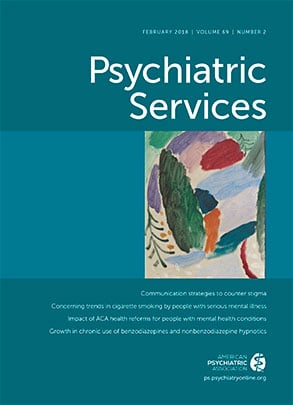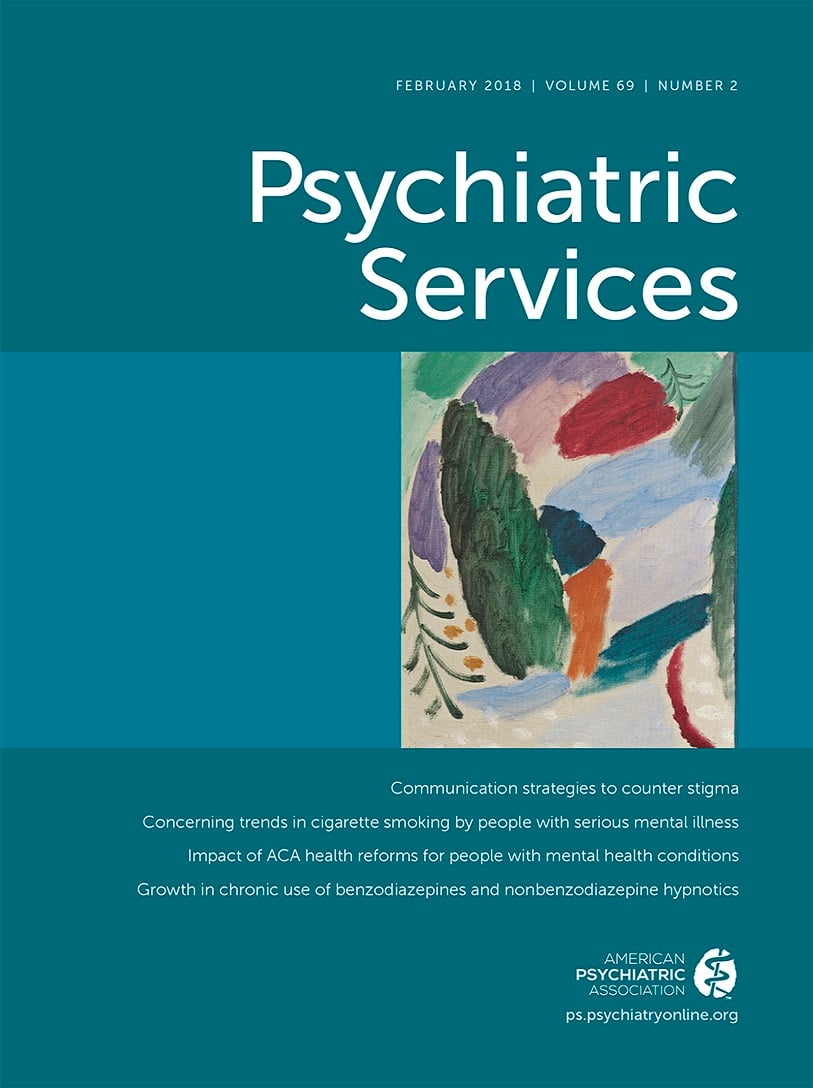Recent work provides new evidence on the positive impact the Affordable Care Act (ACA) has had on insurance outcomes across the United States (
1–
3) and on how ACA reforms and state Medicaid expansion have also improved rates of employment for people with disabilities (
4). In addition to expanding access to insurance, the ACA stipulations that mental health services be included as an essential health benefit at parity with general health services while forbidding coverage exclusions for preexisting conditions suggest that the law should have positive effects for people with mental illness. However, this question remains unanswered.
This brief report explores the hypotheses that people with mental health conditions experience improvement in health insurance, access to care, and employment post- versus pre-ACA reforms and that those who live in a state with expanded Medicaid will experience greater improvements than those in nonexpansion states.
Methods
This study used data from the Health Reform Monitoring Survey (HRMS), a nationally representative Internet survey of nonelderly adults (ages 18–64). The survey draws its sample from the GfK KnowledgePanel (
2,
3), a nationally representative, probability-based Internet panel maintained by GfK Custom Research. The panel was first fielded in early 2013, before ACA implementation. The HRMS is designed to allow rapid-cycle monitoring of changes in coverage, health care access, and affordability under the ACA. In addition, the HRMS sampling frame has been designed to oversample people with low incomes, who are more likely to have high rates of chronic conditions, and to allow comparisons of state-level insurance policy. Adults provide consent to participate in the GfK KnowledgePanel; the study was approved by the institutional review board of the Urban Institute.
We used pooled cross-sectional data from 2013–2016 (N=47,159) for modeling. The question, “Have you been diagnosed by a physician or other qualified medical professional with any of the following medical conditions?” was used to identify respondents with mental health conditions (attention-deficit hyperactivity disorder, anxiety, bipolar disorder, depression, mood or schizoaffective disorders, schizophrenia, or other mental health conditions) in their GfK KnowledgePanel profile. We used adjusted outcomes to compare survey respondents who reported having a mental health condition in September 2013 (N=1,550) pre-ACA implementation to a similar sample in March 2016 (N=1,439) post-ACA implementation. The pre-ACA sample provided a baseline before open enrollment began in the health insurance marketplaces in October 2013 and federal support for the state Medicaid expansion began in January 2014. Family income was imputed for observations with missing information (approximately 3%) by using multiple imputation methods. For the remaining measures, item nonresponse was generally less than 3%, and missing values were not imputed.
Eight outcomes were measured as dichotomous variables. Health insurance coverage was measured by receipt of employer-sponsored health insurance, directly purchased coverage from the ACA marketplace, or Medicaid; report of being uninsured for the full year; and report of being insured for the full year. Access to care was measured by report of a usual source of care, unmet need for care because of cost (positive response to the question, “Thinking about your health care experiences over the past 12 months, was there any time when you needed [any of eight types of care] but didn’t get it because you couldn’t afford it?”), and unmet need for mental health care (positive response to the same question using the referent mental health care). Employment was based on the question, “Are you currently working for pay or self-employed?”
The independent variables of interest capture time pre- and post-ACA reform and state Medicaid expansion status. To measure ACA reforms, pre-ACA reflects data from the September 2013 wave of the HRMS and post-ACA reflects data from the March 2016 wave. State Medicaid expansion status is a dichotomous variable identifying residence in the 27 states and Washington, D.C., that had expanded Medicaid as of December 2014. Selecting this date ensured that Medicaid expansion was implemented by the beginning of the 12-month reference period of our access-to-care measures in our post-ACA data. We also controlled for individual characteristics (age, gender, race, ethnicity, primary language, education, marital status, family income, health status, and metropolitan status) and state-level characteristics (region and age- and gender-matched local employment) at each wave of data collection.
Descriptive statistics show sample characteristics pre- and post-ACA. Two-tailed F tests show unadjusted differences between Medicaid expansion and nonexpansion states post-ACA. Multivariable logistic regression was used to model the association of outcomes with individual and state characteristics, including a two-way interaction of time and state Medicaid expansion status. Heterogeneity of treatment effect was examined with a three-way interaction of time, state Medicaid expansion status, and insurance status (insured all year or not) to explore effects among people who were insured all year but may have experienced improved quality of insurance. All analyses were weighted and used Stata:svyset to account for the complex sampling design. We used predictive margins to test for the marginal effects of time (pre- versus post-ACA) and expansion status, adjusting for differences in the composition of respondents at each wave of the HRMS in a nonlinear model (
5). This process allowed us to use all HRMS data, regardless of whether individuals had repeated measures over time. Findings are presented to reflect effects for the post-ACA sample (
3). An adjusted Wald test was used to determine whether the changes were different from zero pre- versus post-ACA and state Medicaid expansion versus nonexpansion.
Results
In the 2013 HRMS, 1,550 out of 7,911 (18%) adults reported a mental health condition. Among those reporting a mental health condition, 73% (N=1,132) were white non-Hispanic, 10% (N=145) black non-Hispanic, 11% (N=170) Hispanic, 41% (N=638) high school graduates or less, 36% (N=562) with income at or below 138% of the federal poverty level, and 23% (N=361) in fair or poor health [see online supplement]. Post-ACA reforms, people with mental health conditions were more likely to have Medicaid when they lived in Medicaid expansion states (compared to nonexpansion states) and more likely to have directly purchased insurance, to be uninsured all year, or to report unmet need due to cost when they lived in nonexpansion states (compared to expansion states). Employment (54%, or 414, in Medicaid expansion states versus 56%, or 373, in nonexpansion states) and coverage by employer-sponsored health insurance (48%, or 373, in Medicaid expansion states versus 49%, or 327, in nonexpansion states) did not differ by expansion status.
Table 1 shows adjusted outcomes pre- and post-ACA implementation overall and by state Medicaid expansion status. Post-ACA reforms, people with mental health conditions were more likely to be covered by Medicaid (22% versus 13%; t=7.55, df=50, p<.001) and less likely to be uninsured all year (5% versus 13%; t=−6.89, df=50, p<.001), compared with pre-ACA reforms. They were also more likely to report having a usual source of care (82% versus 76%; t=3.11, df=50, p=.002) and less likely to report unmet need due to cost for mental health services (17% versus 21%; t=−3.16, df=50, p=.002) and for any health services (46% versus 51%; t=−3.71, df=50, p<.001). These effects were experienced in both Medicaid expansion and nonexpansion states. However, respondents in Medicaid expansion states experienced significantly larger gains in Medicaid coverage, whereas those in nonexpansion states experienced significantly larger drops in being uninsured all year and unmet need because care was unaffordable. Examination of these trends among people with mental health conditions who were insured all year (N=451 pre-ACA and N=536 post-ACA reforms, data not shown) indicates that, for this group, reductions in unmet need were limited to those in nonexpansion states.
Discussion
People with mental health conditions reported that they were less likely to be uninsured and enjoyed gains in access to care post-ACA reforms. Given the dismal rates of service use (only 41% of people with mental disorders use any mental health services) (
6), morbidity (at least double the relative risk) (
7), and resulting twofold risk of mortality (
8), this is a significant policy achievement. The gains in access to care in nonexpansion states among people who were insured all year are notable. This group may have benefited from improved coverage of mental health and habilitative services made possible by the ACA. Future work should examine changes in patterns of care to identify the factors at work.
People with mental health conditions did not report greater likelihood of employment post-ACA reforms in contrast to gains experienced by people with all kinds of disabilities (
4). The health improvements that people with mental health conditions may enjoy as a result of improved access to care may result in improved employment outcomes over time. There is evidence that people receiving comprehensive care can improve mental health functioning and, subsequently, their rates of employment (
9). Importantly, and contrary to fears, employment rates in this population remained consistent across time and expansion state status, suggesting that people with mental health conditions did not reduce their likelihood of employment or of receiving employer-sponsored health insurance when new Medicaid coverage options became available. Future work should examine employment outcomes over time for this population.
It is important to be clear about what the HRMS data reveal and what they do not. The strength of the HRMS lies in its ability to provide nationally representative samples in rapid succession to provide timely insights into the impacts of the ACA. The resulting serial cross-sectional samples show the impacts of time and state policy on outcomes. They do not allow us to explore factors associated with an individual’s shift in the type of health insurance held or whether that shift is associated with improved access to care. Future work could use panel data to explore the impact of acquiring improved insurance coverage on access to care, health, and long-term outcomes such as employment. Such analyses could determine whether consistency in access to services supports improved health, which could in turn support greater employment among people with mental health conditions. Since the HRMS relies on Internet surveys (with Web-enabled devices provided if necessary), these data are less likely to capture the experiences of people who are less technically savvy. Data developed from survey designs to reach such populations take more time to collect but will be important to examine to understand the benefits of the ACA for the poorest citizens.
Identification of any mental health condition by self-report of specific diagnoses may include people whose mental health conditions have resolved or omit individuals with conditions who have never been diagnosed. Comparison of rates of mental health conditions in the HRMS and in the 2014 National Health Interview Survey (NHIS), which uses the Kessler 6 to indicate moderate or severe psychological distress, indicates that the HRMS includes a somewhat larger proportion of people with mental health conditions (18% versus 10%) (
10). Among the HRMS sample of people with mental health conditions, people more often are white, are college-educated, have above median income, and are married than those with moderate or severe psychological distress in the NHIS. These differences show that our HRMS sample consisted of a broader, higher-functioning group. The analyses presented here intentionally included people with mental health conditions who did and did not report impairment in daily functions because of disability. The goal was to define the sample broadly enough so that changes in insurance and employment status could be seen. In order to examine ACA benefits for the poorest underserved groups, more focused data are required.

